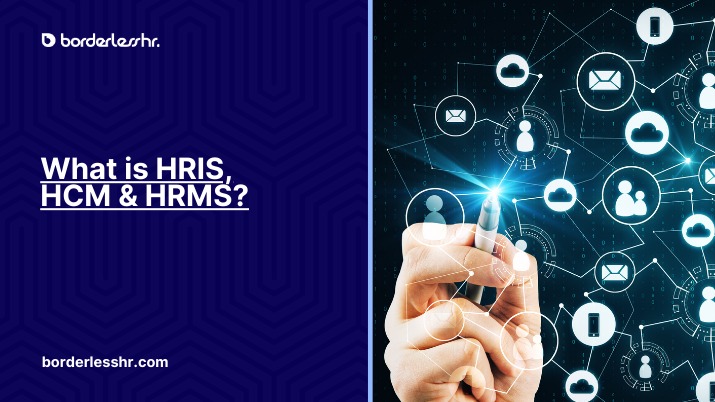The world of human resources (HR) is full of acronyms and technical terms, these terms and technology are of vital importance in the workforce as they help maximize efficiency.
Technology plays a crucial role in achieving this objective, offering a multitude of sophisticated tools collectively known as HR technology. However, navigating the landscape of HR technology can be challenging, with acronyms like HRIS, HRMS, and HCM often creating confusion.
This comprehensive guide aims to address this very challenge. By providing a clear understanding of these key terms and their underlying functionalities, we empower HR professionals and business leaders to make informed decisions about their technology needs.
HRIS: The Data at the Core
Imagine a central repository for all your employee information, from basic contact details and salaries to benefits enrolment and performance records/reviews, and more. That’s the essence of an HRIS, or Human Resource Information System. Think of it as the digital filing cabinet of your HR department, meticulously storing and organizing employee data.
The Core Functionalities of an HRIS Typically Include:
Employee data management: Storing and maintaining accurate employee information, including demographics, contact details, emergency contacts, and job information.
Payroll processing: Streamlining the calculation and disbursement of salaries, deductions, and taxes.
Benefits administration: Managing employee benefits enrolment, claims processing, and communication.
Time and attendance tracking: Monitoring employee work hours, leave requests, and overtime.
Reporting and analytic: Generating reports on key HR metrics, such as employee headcount, turnover rates, and absenteeism.
An HRIS acts as the backbone of any HR department, ensuring data accuracy, streamlining administrative tasks, and facilitating informed decision-making. It’s like having a reliable assistant who keeps everything organized and readily accessible.
HRMS: Expanding the Functionality Spectrum
The Human Resource Management System (HRMS) builds upon the foundation laid by the HRIS. Think of it as an HRIS on steroids, offering a broader range of functionalities beyond data storage and management. An HRMS typically encompasses all the features of an HRIS, along with additional capabilities, such as:
Recruitment and onboarding: Streamlining the recruitment process, managing applications, and facilitating a smooth onboarding experience for new hires.
Performance management: Setting goals, conducting performance reviews, and providing feedback to employees.
Learning and development: Providing access to training materials, tracking learning progress, and managing development programs.
Talent management: Identifying high-potential employees, facilitating career development opportunities, and succession planning.
Employee self-service: Empowering employees to access their own data, update personal information, submit leave requests, and view pay stubs.
An HRMS goes beyond data management, offering a more holistic approach to managing the employee lifecycle. It’s like having a dedicated HR team at your fingertips, automating tasks, facilitating communication, and fostering a positive employee experience.
HCM: The Strategic Shift
Human Capital Management (HCM) takes things a step further, shifting the focus from mere management to strategic optimization of human capital. While encompassing the functionalities of both HRIS and HRMS, HCM goes beyond automation and data management. It emphasizes a strategic approach to talent management, aligning HR practices with the overall business goals.
Key characteristics of HCM include:
Data-driven decision-making: Utilizing HR data to gain insights into workforce trends, identify skills gaps, and make informed decisions about talent acquisition, development, and retention.
Talent analytics: Employing sophisticated analytics tools to measure the impact of HR initiatives and identify areas for improvement.
Employee engagement: Fostering a culture of engagement through initiatives that promote employee well-being, recognition, and development.
Workforce planning: Anticipating future talent needs based on business strategy and proactively developing solutions to address potential gaps.
HCM takes a more holistic view of the workforce, treating employees as strategic assets rather than simply resources. It’s like having a visionary HR leader guiding the organization, leveraging data and technology to unlock the full potential of the human capital and drive business success.
Choosing the Right Fit: Which HR software should I choose for my business?
The choice between HRIS, HRMS, and HCM depends on the specific needs and size of your organization. Here’s a quick guide:
Small businesses: An HRIS may suffice for basic data management and administrative tasks.
Growing businesses: An HRMS can provide a comprehensive suite of functionalities to manage the expanding workforce and its complexities.
Large enterprises: HCM offers a strategic approach to talent management, aligning HR practices with business goals and optimizing workforce performance.
Remember, these terms are not mutually exclusive. Many HR solutions combine functionalities from all three categories, offering different levels of sophistication and customization. The key is to understand your specific needs and choose a solution that empowers your HR team, engages your employees, and drives business success.
How are an HRIS, HRMS, and HCM different?
Let’s outline the differences between an HRIS, HRMS, and HCM one by one:
(HRIS) Human Resources Information System :
- Function: Serves as the foundational layer, centralizing employee data management for core HR functions like payroll processing, benefits administration, and employee record keeping.
- Analogy: Consider it the central database of your HR operations, storing and managing critical employee information.
- Key features: Employee profiles, contact details, payroll records, benefits enrolment, leave tracking, and basic reporting capabilities.
(HRMS) Human Resource Management System :
- Builds upon HRIS: Extends beyond core functionalities by offering tools to manage the entire employee lifecycle, from recruitment and onboarding to performance management, training, and development.
- Analogy: Think of it as the operating system of your HR department, streamlining and automating various employee-related processes.
- Key features: Applicant tracking system, performance reviews, learning management modules, self-service portals for employees, and basic reporting and analytics functionalities.
(HCM) Human Capital Management :
- Most comprehensive: Encompasses the functionalities of HRIS and HRMS but takes a more strategic approach. Focuses heavily on workforce management, talent optimization, and employee experience.
- Analogy: View it as a holistic toolkit for managing your human capital, integrating various modules to drive strategic decision-making, optimize talent, and enhance the employee experience.
- Key features: Talent analytics, workforce planning, succession planning, employee engagement surveys, career development tools, and advanced reporting and data insights.
Key Distinctions:
- Scope: HRIS offers the narrowest scope, focusing on core data management. HRMS offers a broader scope, encompassing the employee lifecycle. HCM boasts the broadest and most strategic scope, emphasizing talent management and employee experience.
- Focus: HRIS prioritizes data management, HRMS emphasizes process automation and employee lifecycle management, and HCM prioritizes strategic workforce management and employee experience.







